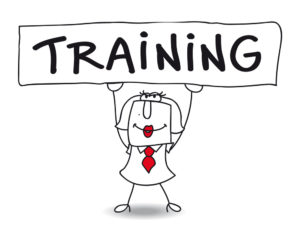 This month, I presented tailored writing and editing training sessions to around 75 people.
This month, I presented tailored writing and editing training sessions to around 75 people.
While I enjoyed the challenge of developing the bespoke content, the actual presenting was a pretty big step out of my usual comfort zone behind the screen.
Thankfully, the face-to-face feedback and evaluation forms were largely very positive.
If (like me) public speaking is not your natural habitat, boost your confidence by brushing up on these good practice tips for engaging presentations.
Content
Make sure your presentation slides are:
- short—minimise the number of slides
- useful—aim for an appropriate mix of images and limited text to reinforce your messages and not distract or overload your audience with too much detailed information (the detailed content should be in the notes rather in the slides themselves)
- simple—minimise visual effects so your audience concentrates on what you are saying, rather than fancy floating, fading or bouncing text on the screen
- clean, professional and consistently set out—ensure the design complements your corporate style and any related handouts
- easy to see and read—use large text and a simple font, limited to a few words per slide.
Preparation and delivery
Before you present:
- Know your objective—Why are you giving this presentation and what do you want your audience to do as a result? Clarify your objective: by the end of my presentation, the audience will…
- Know your audience—Who are they? What is in it for them? Why should they be interested and how will they benefit from what you are telling them? And what style of presenting will suit them best (e.g. formal, informal)?
- Know your topic—work out your main points and support them with relevant facts, examples, personal experiences, stories and statistics as appropriate.
- Make an effort to connect—talk to your audience, not the screen.
- Practice, practice, practice—read your notes out loud to build confidence.
- Anticipate questions—be prepared to answer likely questions and be honest if you need to check and get back to someone later.
- Check your equipment beforehand—have a backup plan just in case.
- Take handouts—tell your audience you will provide handouts, but don’t pass them around until you finish your presentation (otherwise they will read your handouts instead of listening to you).
- Take a deep breath, relax and be yourself—try to be natural, smile and make eye contact.
- Consider when NOT to use PowerPoint—sometimes it’s better to speak directly with your audience. For example, if it’s a small group or more intimate setting, or if a guided tour or hands-on demonstration would be more persuasive.
And a final bonus tip…
- When all else fails, default to chocolate.

‘Make sure you have finished speaking before the audience has finished listening’
Dorothy Sarnoff
| Cinden Lester has more than 25 years’ experience as a professional writer, editor and communications specialist. She worked as a broadcast journalist, in private sector marketing and public relations, and in government communications before establishing her own Canberra-based communications consultancy in 2000.
Contact Cinden if you’d like help with your communications. |

